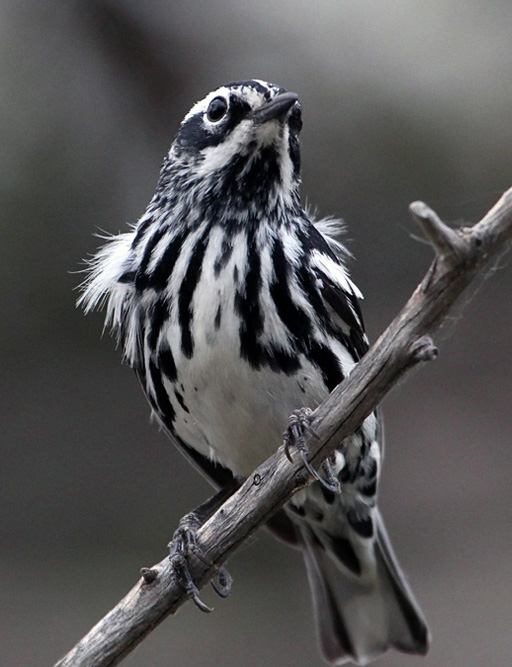By John Shackford

One of the few warblers that nests in the Oklahoma City area is the Black-and-white Warbler (Mniotilta varia). J. E. Holloway (2003. Dictionary of Birds of the United States. Timber Press, Inc. Portland Oregon.) states that Mniotilta means “moss plucker” which “came from the belief that moss was consistently used in the nests,” and varia which means “two or more contrasting colors.”
This warbler usually nests on the ground. As of 1982 G. M. Sutton [Sutton Summaries of bird species, Sam Noble Okla. Museum of Nat. Hist. Norman, OK] had recorded only two records of actual nests in Oklahoma: the first in Caddo County (central Oklahoma) on May 26, 1954, “nest (4 small young) found ‘under grass tussock along canyon rim’”; and one in Delaware County (northeastern Oklahoma) on May 12, 1956, “nest (several young, just leaving) found at foot of steep slope near head of Lower Spavinaw Lake”.
I have been lucky enough to find a nest of the Black-and-white Warbler in the Oklahoma City area at Draper Lake. I and others were doing research to try to save a small population of Black-capped Vireos there. On 22 May 2003, I followed a male vireo into a small wooded ravine and began looking for a vireo nest (most of the research aimed at removing any Brown-headed Cowbird eggs found in vireo nests). After standing still in the small ravine for perhaps two minutes looking and listening for Black-capped Vireos, I suddenly saw a female Black-and-white scurry along the ground about 6 ft. in front of me and then run for a total of about 9 ft. before flying. Suspecting a nest, I looked at the area she had come from and saw three clumps of little bluestem grass. One of these clumps held the nest; the nest opened at the side, toward the west. In the nest were four large nestlings; I did not hang around long, trying to minimize the chance of my leading predators to the nest.
Five days later (27 May) the nest was full of very large nestlings, and I realized these undoubtedly were four cowbird chicks (the first report of cowbird parasitism of the Black-and-white Warbler in Oklahoma). Also on this date I watched the nest from 15 ft. away as the male came to feed the young; he invariably would land about 6-8 in. up on the trunk of a 3-in. diameter small oak about a foot from the nest, walk down the trunk to the ground and enter the nest; the female would bring in food nearby but would not approach the nest.
On May 29 I returned with a big camera lens to photograph the birds, but the young had already fledged. There were two unhatched eggs in the nest and a third broken egg, no doubt warbler eggs. These eggs, apparently the first of this species to be found in Oklahoma, were deposited in the avian collection at the Sam Noble Oklahoma Museum of Natural History at OU (OMNH # E-2674). For more information on this nesting see Shackford (J.S. 2004, Black-and-white Warbler nest in habitat also used by Black-capped Vireo, Cleveland County, Oklahoma. Bulletin of the Oklahoma Ornithological Society 37: 17-22).
It is interesting that two of the three Black-and-white Warbler nests that have been found in Oklahoma were during studies of the Black-capped Vireo. The 1954 nest in Caddo County was found during research Jean Graber did for her doctorate, her work still the definitive work on the Black-capped Vireo, while my 2003 nest was also found during Black-capped Vireo research. It leads one to suspect (although this is a vanishingly small sample size) that many nesting habitat requirements for the Black-capped Vireo are also good nesting habitat for Black-and-white Warblers.
As to the fate of the Black-capped Vireo colony, it finally failed. Black-caps nest where both grassland and very shrubby trees are intermixed. Our study area was about 25 acres of post and blackjack oaks habitat that had burned over several years before. As the oaks grew taller, acceptable habitat for the vireos continued to be lost.
Back to the Black-and-white Warbler: one thing I really like about them is their ability to run both up and down tree trunks. The only other U. S. species I know that can do this are the nuthatches. Virtually all this warbler’s diet is “animal,” not “vegetable.” Early on in the spring, Black-and-white Warblers, because they can eat “bugs” gleaned primarily from tree bark before leaves emerge, can find food earlier than most other spring migrants, which depend more on bugs found later on emerging tree leaves.
